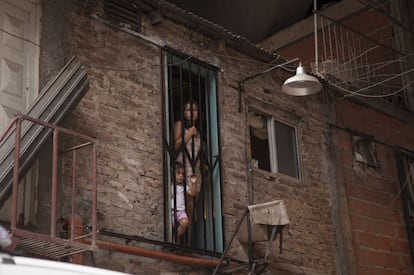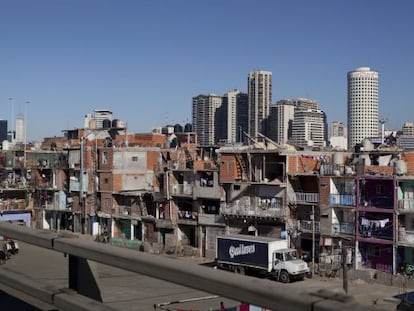The shantytown misery that Buenos Aires is struggling to hide
City Hall places plants and puts up walls to keep Villa 31’s poverty from eyes of motorists


It is almost impossible to ignore, but some people still manage to. In the center of Buenos Aires, around 200 meters from one of the city’s most expensive neighborhoods, the sprawling Villa 31 shantytown has been a long-standing and somewhat embarrassing fixture in the Argentinean capital.
This poor neighborhood of dilapidated makeshift homes is squeezed between train tracks and a major highway. It has resisted dictatorships, crises, recoveries and downturns – no one has been able to raze it.
The city government has put up walls, installed wire meshing and planted vegetation to protect residents and keep the neighborhood from encroaching upon the highway, according to officials. But many in Villa 31 believe that these are attempts to isolate them and hide the view from passing motorists.
Nevertheless, it is almost impossible to cover the entire area.
Over the past decade, the population of Villa 31 has doubled. Between 40,000 and 50,000 people now live there in dangerous conditions, with rival Peruvian and Paraguayan drug gangs fighting for control of the trade.
Villa 31 has resisted dictatorships, crises, recoveries and downturns – no one has been able to raze it
Five people, including a 14-year-old, have been killed in the last month – a record for Villa 31 despite the fact that murder is not such a rare occurrence in the neighborhood.
“The situation is red hot,” says Jorge, who has been living in Villa 31 for 40 years. “The drug traffickers want to map out their own territory now that there is a new government.”
“And while we are down here losing our children to crack cocaine addiction, which they mix with xylazine [a horse tranquilizer], up there they are trying to plant a forest to keep everyone from seeing the poverty from the highway.”
Jorge has two children who are addicts and runs an organization, Si a la vida (Say yes to life), to help keep youngsters off drugs.
Buenos Aires, whose new mayor Horacio Rodríguez Larreta succeeded Mauricio Macri after he was elected the country’s new president, wants to integrate Villa 31 into the rest of the capital.

“The city has no plans to cut off Villa 31,” says Diego Fernández, the city’s urban and social integration secretary. “Instead, we want to integrate it.”
He adds that the plants and wire meshing were installed after reaching a consensus with the neighbors, who said they were tired of motorists throwing their trash and other scraps from the vehicles down into the mishmash of dwellings.
But Gabriel, who runs a Justice Ministry’s aid office inside Villa 31, says the neighborhood was the “perfect example of exclusion.”
“The people who live here are those who work in the homes and offices of the wealthy who live in the city’s center,” he says.
The majority of the predominantly migrant workers who live here cannot afford any other place to live. A room without a bath goes for about 1,500 pesos ($110) but the renter doesn’t have to pay taxes or utilities, and no one asks for residency papers.
“The city has no plans to cut off Villa 31. Instead, we want to integrate it”
Villa 31 has been around for 30 years and those who live in the shantytown are squatters.
Many fear that one day the houses will be razed and the area given over to land speculation. Villa 31 is situated in one of the best areas of Buenos Aires, near the Plate River.
But not many people seriously believe that the government will be able to evict all 40,000 residents from the neighborhood. During the dictatorship (1976-1983), an attempt by the military to force residents out proved unsuccessful. Other shantytowns were created but people started coming back to Villa 31.
Marta, another longtime resident, who helps disabled people, says things have grown more complicated in the last few years.
“I have been here since 1983 and it’s worse than ever,” she says. “I sold my home so that I could help my children leave the shantytown, and I managed it. But I am still here – now I rent. I want to be here and help people. I sold my house on the black market, as everyone does – there are no papers to sign, it is all done on a person’s word.”
Marta says a lot of people have managed to leave Villa 31 and move to homes in private neighborhoods. “They make a lot of money, but everything is negotiated under the table,” she explains. “Those who travel on the highway want to ignore us but we are here and we need help.”
“Whatever you need, you can find it here. You don’t pay for utilities, you don’t pay taxes – life is given to you here”
By law, no one can bring construction materials into Villa 31, but at the same time it is not clear who should be stopping them. The police watch several construction workers pass in front of them carrying bags of cement and other materials into the shantytown.
“I don’t know how all these materials are allowed through, but it is becoming more frequent,” says one of the officers. “Whatever you need, you can find it here. You don’t pay for utilities, you don’t pay taxes – life is given to you here. I am here every day but I would never live in the shantytown. Life is too tough there.”
Forty officers are assigned to protect 40,000 people.
“Life isn’t worth two mangos here,” says Emanuel, another officer who has been assigned to Villa 31 for the past four years. “People don’t leave here; they just go to work and then they come back. We see it all – rapes, murder, physical abuse. At this bar, there was a girl who was being exploited as a prostitute,” he says while pointing to El Playón.
“Over there was a drug distribution point that we broke up,” he says, pointing to the floor of one building.
“This is getting worse by the day, with people getting poorer,” Emanuel says.
But Andresa, another longtime resident, appears more optimistic.
“Before, there were no police officers. Now they are here every day so we are a bit better off. They have installed sewers, electricity and water. Yes, there are a lot of drug traffickers but the streets are safer. We learn the next day who died among them.”
English version by Martin Delfín.
Tu suscripción se está usando en otro dispositivo
¿Quieres añadir otro usuario a tu suscripción?
Si continúas leyendo en este dispositivo, no se podrá leer en el otro.
FlechaTu suscripción se está usando en otro dispositivo y solo puedes acceder a EL PAÍS desde un dispositivo a la vez.
Si quieres compartir tu cuenta, cambia tu suscripción a la modalidad Premium, así podrás añadir otro usuario. Cada uno accederá con su propia cuenta de email, lo que os permitirá personalizar vuestra experiencia en EL PAÍS.
¿Tienes una suscripción de empresa? Accede aquí para contratar más cuentas.
En el caso de no saber quién está usando tu cuenta, te recomendamos cambiar tu contraseña aquí.
Si decides continuar compartiendo tu cuenta, este mensaje se mostrará en tu dispositivo y en el de la otra persona que está usando tu cuenta de forma indefinida, afectando a tu experiencia de lectura. Puedes consultar aquí los términos y condiciones de la suscripción digital.
More information
Archived In
Últimas noticias
Welcome to the post-religion era: The idea of Christianity as the absolute truth has become obsolete
‘I thought you would like it’: The risky sexual practice popularized by TV shows and TikTok
The digitalization of tourism: ‘They promise experiences and gave us the worst possible one’
Mexican peso defies uncertainty with forecasts of a new period of stability in 2026
Most viewed
- Sinaloa Cartel war is taking its toll on Los Chapitos
- Reinhard Genzel, Nobel laureate in physics: ‘One-minute videos will never give you the truth’
- Oona Chaplin: ‘I told James Cameron that I was living in a treehouse and starting a permaculture project with a friend’
- Why the price of coffee has skyrocketed: from Brazilian plantations to specialty coffee houses
- Silver prices are going crazy: This is what’s fueling the rally









































